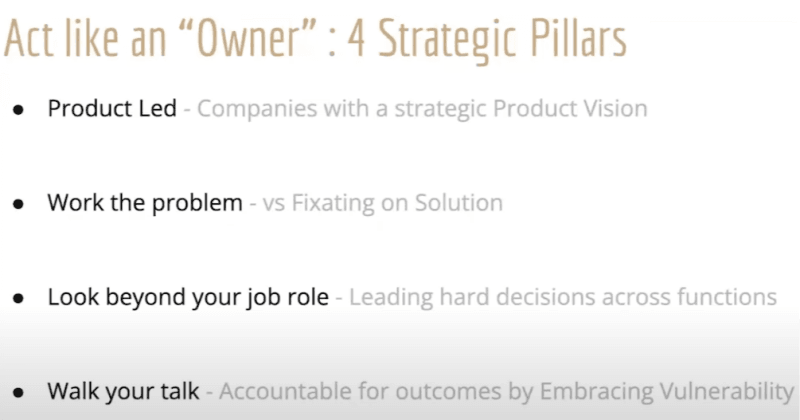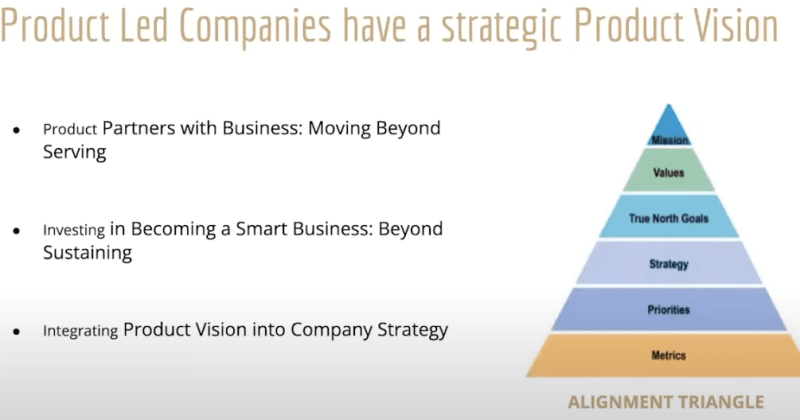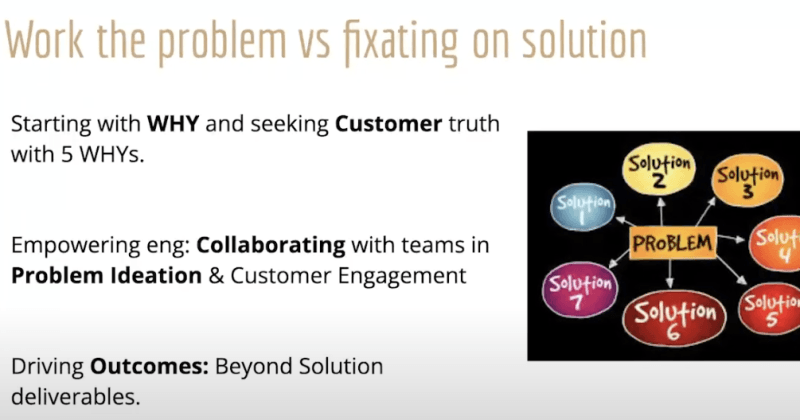Updated: June 18, 2025- 9 min read
Unlocking your utmost potential isn't just about the tools you use or the processes you adopt; it boils down to mindset - particularly an ownership mindset. But why zero in on the concept when discussing the success of a Product Manager? The answer is straightforward: an ownership mindset delivers results.
Editorial note: This post is based on a talk by Bhavini Soneji, Cruise fmr VP Product Eng, on Mastering Ownership Mindset: Unlocking Your Potential as a PM and contains additional insights and examples from the Product School team. You can watch the webinar in full above.
What does success look like for a Product Manager? At its core, it's about crafting outstanding products, championing the needs of your customers, and advancing your business objectives. And the pivotal ingredient in this recipe for success is developing that ownership mindset.
Those who truly embody this mindset possess a steadfast conviction in their mission. They thrive amidst uncertainties, continuously hunting for avenues to expand their knowledge. Their resilience is commendable; they power through obstacles, innovating with creative solutions at every turn. These individuals view challenges with a wide lens, embracing novel opportunities and bridging any knowledge or skill gaps fearlessly. For them, commitment isn't just a word; it's a philosophy.
Act like an owner: the four pillars to unlock your product leadership potential

True excellence isn't just about managing timelines or coordinating teams. It's about embodying a distinctive ownership mindset. To truly soar in your PM journey, there are four foundational pillars to grasp and internalize. These principles hold true whether you're diving into tasks as an individual contributor or leading teams from a managerial perch.
1. Be product-led
In today's dynamic market, thriving businesses are those that position their products at the heart of their strategies. Understand this transformation. Immerse yourself in it. When your organization is genuinely product-led, it's not just about launching products but about steering the entire company's direction with the product as its compass.
Imagine a space where the product isn't just a tool, but a core partner, co-piloting business journeys. Here, technology isn't merely a function—it’s an enabler, bridging the gap between product strategies and overarching organizational goals.

Ask yourself, is your product leadership in the boardroom, actively shaping the company's future? If the answer is no, you're not alone. Too many organizations sideline product teams, often leading to feelings of frustration and missed opportunities. In this new age of business, leadership needs to recognize and harness the synergy between product, technology, and invaluable customer insights.
Prioritize back-office investments
While user-facing features are vital, failing to prioritize and understand the role of back-office tools is a blunder. For instance, at Cruise, emphasizing the operator persona—a figure central to fleet management—was pivotal to the company's success.
Crafting a cohesive product vision
In truly product-led organizations, product vision isn’t an isolated goal—it's ingrained in the company's DNA. Picture the North Star, where mission, values, strategies, priorities, and metrics converge. This isn't just a fancy diagram—it's a beacon, guiding every project, meeting, and strategy session. Such an alignment ensures that companies remain cohesive as they scale. It empowers teams to sprint towards their goals, anchored by a shared vision.
Diving into transformation tales, Disney and PepsiCo serve as exemplary narratives. Disney's CEO, Robert Iger, laid out a three-pillared strategy: prioritizing storytelling, embracing technology, and globalizing the brand. In contrast, PepsiCo's ex-CEO, Indra Nooyi, championed a 'performance with purpose' strategy. This forward-thinking approach sought to balance financial objectives with environmental and societal goals, transforming the brand into a more sustainable and customer-centric entity.
2. Work the Problem

As a Product Manager, your mindset shouldn't be about merely addressing issues. In your quest to be quick solution providers, you often gloss over the essence of the problem. For Product Managers like you, a deeper understanding is not just a desire—it's a necessity. It requires you to pause, listen, and truly comprehend the voice of your customers. This method not only fosters humility but also saves you from the “know-all” mindset.
The power of the five whys
This approach digs deeper, pushing boundaries until the core problem is unearthed. Let's illustrate: At face value, an incident is just a server error. But prod further with the five whys, and you might unveil that the customer messaging was off, or perhaps team response mechanisms were inadequate.
This technique provides a holistic understanding, allowing for a comprehensive remedy rather than a mere quick fix.
The essence of collaboration
Once you've grasped the problem's nuances, how do you rally the troops? Collaboration is the key. Rather than presenting a ready-made solution to your design and engineering teams, immerse them in the problem. Involving them in the ideation process ensures that solutions are created from collective intelligence, not unilateral decisions.
Outcome-driven approach
Beyond crafting solutions, clarity in desired outcomes is paramount. Shipping a feature or launching an experiment is only the beginning. The real challenge lies in assessing whether these solutions resonate with the intended goals. Are they yielding the expected outcomes? If not, it’s back to the drawing board. By keeping the focus on outcomes, you ensure that your efforts are impactful, not just quantitatively productive.
Consider this: an experiment goes live, only to later discover that teams had varying interpretations of metrics. Such oversights not only cost time but can derail entire projects. Clear goal-setting and meticulous planning can safeguard against such missteps.
Let's pivot to some real-world tales. Reflect upon an incident at Headspace. Driven by the allure of trending community features, a full-fledged solution that had enveloped the tech scene, the decision to create a feature felt almost instinctive and it was crafted without diving deep into the core problem. It was a decision prompted more by the fear of missing out (FOMO) than by validated user demand. The result? A misaligned product that missed the mark with its users.
Another real-world example is the Fisher Pen Company, known for their "space pen" for astronauts—a million-dollar investment. As a white paper for those curious to learn more, this case was a fixation on the solution versus being open to exploring other means to meet the end goal. Was this a case of over-engineering? Perhaps. But it underscores the importance of exploring multiple avenues to achieve a goal.
3. Looking beyond your job role
While your title might spell out a set of responsibilities, true product champions look beyond these boundaries. Learn about challenges and operations that may not directly fall into your purview and envision this as your "sphere of influence," not confined to engineering, design, or product, but spilling over into sales, marketing, support, and operations.

As the leader of your product, you wear many hats and have the onus to champion all stakeholders.
Break down silos and foster unity
For a moment, think of the 'big picture'. As product managers, you have a panoramic view. But how do you harness this? How do you bridge perceived gaps without succumbing to a culture of blame?
Champions lead by example. When divisions arise, leaders step in, dissolving silos. Reflect upon instances where a lack of trust might have impeded progress. The solution isn't always in confrontation but in collaboration. Forming cross-functional teams can set the stage for open dialogue, paving the way for collective problem-solving and a shared sense of purpose.
Refining the art of decision-making
Delving into the nuances of a product manager's journey, decision-making often stands out as a Herculean task. Take roadmaps, for instance. These blueprints often become battlegrounds, with every function staking its claim.
True leadership means crafting a roadmap that's attuned to both the customer's voice and business imperatives. Such a roadmap doesn't just spotlight features but also highlights operational bottlenecks, pending bugs, or any factor that could impede a seamless user experience.
To further enrich your decision-making prowess here are 2 techniques to excel:
Solutions excellence
This approach transcends the mere creation of features and stresses a holistic approach, considering the value, feasibility, usability, and viability of solutions. When plotting your roadmap, don't just focus on 'what' but also on the 'how,' ensuring that the implementation resonates with the broader vision.
Decision-making framework
Familiarize yourself with the 'one-way' vs. 'two-way' door framework, popularized by Amazon. 'One-way' decisions, irreversible in nature, require meticulous planning. On the contrary, 'two-way' decisions are reversible and thus can be made swiftly. Distinguishing between the two can empower teams to act with agility, leveraging data-driven insights and customer feedback.
4. Walk your Talk
It's not just about vision. It's about action. In the world of product management, credibility is earned when your words align seamlessly with your actions. Ensure that your decisions, strategies, and daily tasks reflect the principles and visions you champion.
Raise your hand
Ever found yourself grappling with a concept, but felt too nervous to ask a question? You're not alone. But remember, each time you muster the courage to voice that uncertainty, you're inadvertently echoing the silent queries of others. So, the next time you have a doubt, take a leap. Ask.
Acknowledge your mistakes
Not every theory will hit the bullseye. And that's okay. But within these setbacks lie invaluable lessons. It's essential to recalibrate, refocus, and move forward, imbibing the insights gleaned from these missteps.
Furthermore, it's commendable to re-evaluate, pivot, or even admit an oversight as new data surfaces. This adaptability not only keeps you grounded but also fosters a culture of collective learning.
Own your impact
Your role is more than just managing products; it's about being acutely aware of the ripple effects of your decisions. So, exercise caution. Avoid the allure of the latest trend and remain laser-focused on your objectives.
In short, embracing these four pillars isn't merely about enhancing your skills—it's about evolving your very mindset. So, as you navigate the intricate maze of product management, remember: acting like an owner doesn't mean merely taking charge. It means thinking, deciding, and leading with an unwavering commitment to excellence.
Learn more with Product School
Master the ownership mindset and lead your Product teams to success with our Product Leader Certification (PLC)® designed by successful Product Managers to help you build end-to-end product development skills while offering the hands-on experience you need to lead product teams.
Discover the PLC today, and take the first step towards becoming a strategic, successful, and influential Product Manager. Schedule a call today to find out more.
Updated: June 18, 2025





